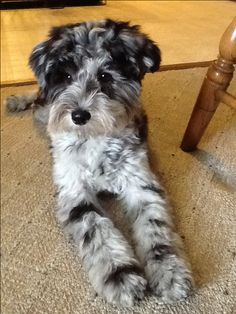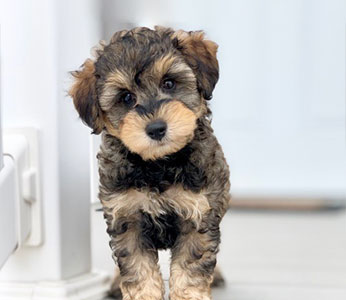Mini Schnoodle Breed Information


The Mini Schnoodle is a popular designer dog breed, a cross between the Miniature Schnauzer and Miniature Poodle. This hybrid breed has gained attention for its friendly demeanor, high intelligence, and hypoallergenic coat, traits that make it a great fit for many households. Their small size and low-shedding coat add to their appeal, especially for those living in smaller spaces or those with allergy concerns.
As a mixed breed, the Mini Schnoodle is known for its versatility. These dogs are well-suited to families, singles, and even seniors, thanks to their affectionate nature and moderate exercise needs. Whether you live in an apartment or a house with a yard, Mini Schnoodles can adapt and provide companionship, loyalty, and endless affection.
Characteristics
- Intelligent and Trainable: Mini Schnoodles inherit a high level of intelligence from both parent breeds. They are eager to learn and very easy to train.
- Compact Size: Standing at 12-15 inches and weighing 10-20 pounds, Mini Schnoodle adults are well-suited for apartments or homes with limited space.
- Family-Oriented: Their affectionate nature allows them to integrate well into family life, especially with children.
- Protective Instincts: Thanks to their Schnauzer background, Mini Schnoodles can be alert and protective and serve as effective watchdogs.
- Good with Other Pets: These dogs are typically friendly and get along with other animals if socialized early.
- Low-Shedding, Hypoallergenic Coat: Their coat, often low-shedding, makes them a good option for allergy sufferers.
- Moderately Energetic: Mini Schnoodle dogs require regular exercise. They thrive on daily walks and mentally stimulating activities.

Appearance
Mini Schnoodles are small to medium-sized dogs, typically weighing between 10 and 20 pounds and standing 12 to 15 inches tall at the shoulder. Their size makes them suitable for various living environments, from city apartments to homes with larger yards. Despite their relatively compact stature, they maintain a sturdy build, which is inherited from their Miniature Schnauzer parent, while retaining the graceful agility often associated with Poodles.
The coat of the Mini Schnoodle is one of the breed’s defining features. Most Mini Schnoodles inherit a wavy or curly coat from their Poodle parent, which is typically low-shedding and often considered hypoallergenic. This characteristic is highly beneficial for individuals with allergies. Their coats come in various colors, ranging from black, white, gray, and brown to multi-colored or parti-colored coats. Due to the coat's texture, regular grooming is required to prevent matting and maintain its softness.
In terms of facial appearance, Mini Schnoodles often exhibit the distinctive Schnauzer features, particularly the beard and eyebrows, which contribute to their charming and expressive look. Their eyes are typically dark and intelligent, reflecting their alert and curious nature. Owners can choose different grooming styles for their Mini Schnoodle, from the “teddy bear” cut to a more traditional Schnauzer trim, depending on personal preference and the dog's coat type.
Temperament
The temperament of a Mini Schnoodle is characterized by a blend of intelligence, affection, and alertness. Due to their Poodle and Schnauzer lineage, Mini Schnoodle dogs are highly trainable and tend to form strong bonds with their families. They are known to be loyal and make excellent companion dogs for both families and individuals.
Mini Schnoodles are generally social and do well with children and other pets when properly introduced. They enjoy mental stimulation, so training and puzzle games help keep them engaged. While they are typically friendly, their Schnauzer ancestry means they can also be cautious around strangers, and can exhibit watchdog tendencies.
Care
Grooming
Mini Schnoodles require regular grooming due to their low-shedding, often curly or wavy coat. It is recommended to brush their coat two to three times per week to prevent matting and tangles, especially if their fur is on the longer side. Grooming frequency may vary depending on the length and texture of the coat, but regular brushing helps maintain its softness and health.
A professional grooming session every 6 to 8 weeks is also essential to keep their coat at an appropriate length. In addition to coat maintenance, attention should be given to their ears. Since Mini Schnoodles have floppy ears, regular cleaning is necessary to prevent ear infections, which can occur due to trapped moisture or debris.
Additional grooming tasks include regular nail trimming and dental care. Their nails should be clipped every few weeks to avoid discomfort or injury, while brushing their teeth several times a week can help prevent dental issues such as plaque buildup or gum disease.
Exercise Needs
Mini Schnoodles are a moderately energetic breed that requires regular daily exercise to maintain their physical and mental health. They do well with 30 to 45 minutes of moderate exercise each day, which can include walks, playtime, or even interactive games. Their size allows them to exercise comfortably in smaller spaces, which makes them popular for apartment living, provided they receive sufficient outdoor activity.
In addition to physical exercise, Mini Schnoodles also require mental stimulation due to their high intelligence. Engaging them with puzzle toys, obedience training, or games that challenge their minds can prevent boredom and reduce the likelihood of destructive behaviors. Without adequate mental and physical stimulation, they may develop undesirable habits, such as excessive barking or chewing.
Although Mini Schnoodles are active, they also enjoy downtime with their families. After a good walk or a play session, they are content to relax and spend time with their owners. This balance of energy and calmness makes them versatile companions for households with varying activity levels.
Health
Mini Schnoodles are typically healthy dogs, though a few minor health issues are worth monitoring. Dental disease is a common concern for smaller dog breeds, including Mini Schnoodles. Due to the shape and size of their mouths, they may experience plaque buildup more quickly, which can lead to gum disease if not properly managed. Regular dental care, such as brushing and professional cleaning, is crucial to maintaining their oral health.
Some Mini Schnoodles may develop mild skin allergies. These allergies can be triggered by various factors, including environmental allergens or specific ingredients in their food. Symptoms often include itching or skin irritation, and in more serious cases, digestive issues. With proper veterinary guidance, these allergies can be managed through changes in diet or lifestyle.
Ear infections are another minor but common issue for small dogs like Mini Schnoodles, especially those with floppy ears. Moisture or debris trapped in the ear can lead to discomfort or mild infections. Routine ear cleaning and checks can prevent these infections and keep your Mini Schnoodle feeling their best.
Lifespan
The average lifespan of a Mini Schnoodle ranges between 12 and 16 years. Factors that contribute to their longevity include regular veterinary care, a balanced diet tailored to their age, and an appropriate amount of exercise to maintain their overall well-being. While genetics plays a role in their lifespan, a proactive approach to health monitoring can significantly enhance their quality of life in later years.
As they transition into their senior years, it’s advisable to adapt their care routine to support their changing needs. This may include switching to a diet formulated for older dogs, closely monitoring their joint health, and adjusting exercise levels to prevent overexertion.
Training
Mini Schnoodles are highly trainable due to their intelligence and eagerness to please, traits they inherit from both the Miniature Schnauzer and Poodle. Basic obedience training should start early to establish good behavior habits, and it is recommended to use positive reinforcement techniques such as treats, praise, and playtime rewards. These methods help to encourage quick learning while also fostering a strong bond between the owner and the dog.
In addition to basic commands like “sit” and “stay,” Mini Schnoodles also excel in more advanced training due to their quick learning abilities. Keeping training sessions short and engaging will help maintain their attention and prevent boredom. While they are intelligent, they also require consistency and patience to ensure that their playful nature doesn’t lead to undesirable behaviors like jumping or barking excessively.
Socialization is another key component of training for Mini Schnoodle puppies. Exposing them to different environments, people, and animals at an early age helps reduce the likelihood of fear or anxiety in new situations. Given their natural alertness, they may be cautious around strangers, so early and regular socialization is critical for developing a well-adjusted and confident dog.
History
The Mini Schnoodle originated in the 1980s, part of a movement toward creating hybrid dogs that combined the best features of two different purebred breeds. Breeders carefully selected Miniature Schnauzers and Miniature Poodles for their desirable traits—intelligence, low-shedding coats, and affectionate temperaments. By crossing these two breeds, the goal was to develop a dog suited for families and individuals seeking a trainable, adaptable pet.
The combination of Schnauzer and Poodle qualities proved successful. The Mini Schnoodle’s hypoallergenic coat, a hallmark of the Poodle, made it a popular choice for those with allergies. Additionally, the breed’s alertness and protective instincts, inherited from the Schnauzer, gave it watchdog-like abilities, which made it a versatile and well-rounded companion. This blend of traits has helped the Mini Schnoodle establish itself as a favored choice for dog lovers.


